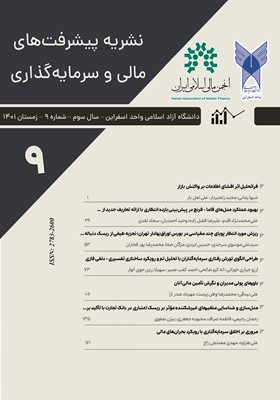طراحی الگوی تورش رفتاری سرمایهگذاران با تحلیل تم و رویکرد ساختاری تفسیری - دلفی فازی
محورهای موضوعی : سرمایهگذاریآرزو جباری خوزانی 1 , اله کرم صالحی 2 * , احمد کعب عمیر 3 , سهیلا زرین جوی الوار 4
1 - گروه حسابداری، واحد اهواز، دانشگاه آزاد اسلامی، اهواز، ایران.
2 - گروه حسابداری، واحد مسجدسلیمان، دانشگاه آزاد اسلامی، مسجدسلیمان، ایران.
3 - گروه حسابداری، واحد اهواز، دانشگاه آزاد اسلامی، اهواز، ایران.
4 - گروه مدیریت بازرگانی، واحد آبادان، دانشگاه آزاد اسلامی، آبادان، ایران.
کلید واژه: دلفی فازی, تحلیل مضمون, تورشهای رفتاری, رویکرد ساختاری تفسیری,
چکیده مقاله :
هدف: هدف پژوهش حاضر طراحی الگوی تورش رفتاری سرمایهگذاران با تحلیل تم و رویکرد ساختاری تفسیری - دلفی فازی میباشد.روششناسی پژوهش: پژوهش حاضر در زمره پژوهشهای آمیخته با رویکرد کیفی و کمی است که در بازه زمانی 1399 الی 1400 انجام شده است و از نظر هدف، اکتشافی و از حیث ماهیت و روششناسی، توصیفی پیمایشی است. جامعه آماری پژوهش را مدیران و کارشناسان در حوزه بازار سرمایه و خبرگان دانشگاهی تشکیل میدهند که با استفاده از اصل کفایت نظری و روش نمونهگیری گلولهبرفی 16 نفر از آنان بهعنوان اعضای نمونه انتخاب گردید. در بخش کیفی پژوهش از روش تحلیل مضمون (تم) برای شناسایی عوامل اثرگذار بر تورش رفتاری استفاده گردید و برای جمعآوری دادهها از مصاحبه نیمهساختاریافته (عمیق) بهره گرفته شد. همچنین در بخش کمی برای گردآوری اطلاعات از پرسشنامه و برای تعیین اثرگذارترین مؤلفهها، از تحلیل ساختاری تفسیری و تحلیل میکمک استفاده شده است.یافتهها: یافتهها در بخش کیفی با استفاده از تحلیل مضمون نشان داد که عوامل مؤثر بر تورش رفتاری سرمایهگذاران در ایران متشکل از ویژگیهای شخصیتی، دامهای ادراکی و رفتاری، نقشه سفر مشتری، ظهور ذهن جمعی، نظریه رفتار مکاشفهای، نظریه چشمانداز، نظریه بازار و ناهماهنگی شناختی میباشد.اصالت / ارزشافزوده علمی: نتایج پژوهش مشتمل بر شناسایی و اولویتبندی مهمترین عوامل اثرگذار بر تورش رفتاری سرمایهگذاران است که درنهایت 8 مؤلفه اصلی و 33 مضمون تعیینکننده از نظر خبرگان شناسایی شد که میتواند برای شفافسازی تصمیمگیریهای سرمایهگذاران، تحلیل بهتر و بهبود کارایی بازار سرمایه مورداستفاده قرار گیرد.
Purpose: The purpose of the current research is to design the behavioral bias pattern of investors with theme analysis and fuzzy interpretative-Delphi structural approach.Methodology: This research is one of the mixed researches with qualitative and quantitative approach that was carried out in the period of 2020-2021. The statistical population of the research consists of managers and experts in the field of capital market and academic experts, and 16 of them were selected as sample members using the principle of theoretical adequacy and the snowball sampling method. In the qualitative part of the research, the method of theme analysis was used to identify the influencing factors on behavioral bias and to collect data, a semi-structured (in-depth) interview was used. Also, in the quantitative section, a questionnaire was used to collect information, and interpretive structural analysis and MICMAC analysis were used to determine the most effective components.Findings: The findings in the qualitative part using thematic analysis showed that the factors affecting the behavior biases of investors in Iran is consist of personality traits, perceptual and behavioral traps, customer journey map, emergence of collective mind, revelatory behavior theory, perspective theory, market theory and cognitive alignment.Originality / Value: The results of the research include the identification and prioritization of the most important factors influencing the behavior of investors, and finally, 8 main components and 33 determining themes were identified according to experts, which can be used to clarify the investors decisions, better analyze and improve the capital market efficiency.
Ritter, J. R. (2003). Behavioral finance. Pacific-Basin Finance Journal, 11(4), 429–437.
Wilde, G. J. S. (1998). Risk homeostasis theory: an overview. Injury Prevention, 4(2), 89–91.
_||_

